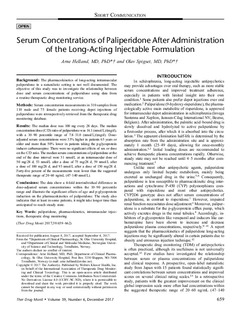| dc.contributor.author | Helland, Arne | |
| dc.contributor.author | Spigset, Olav | |
| dc.date.accessioned | 2018-01-18T13:14:16Z | |
| dc.date.available | 2018-01-18T13:14:16Z | |
| dc.date.created | 2018-01-03T11:27:04Z | |
| dc.date.issued | 2017 | |
| dc.identifier.citation | Therapeutic Drug Monitoring. 2017, 39 (6), 659-662. | nb_NO |
| dc.identifier.issn | 0163-4356 | |
| dc.identifier.uri | http://hdl.handle.net/11250/2478165 | |
| dc.description.abstract | Background: The pharmacokinetics of long-acting intramuscular paliperidone in a naturalistic setting is not well documented. The objective of this study was to investigate the relationship between dose and serum concentrations of paliperidone using data from a routine therapeutic drug monitoring service.
Methods: Serum concentration measurements in 310 samples from 110 male and 75 female patients receiving depot injections of paliperidone were retrospectively retrieved from the therapeutic drug monitoring database.
Results: The median dose was 100 mg every 28 days. The median concentration/dose (C/D) ratio of paliperidone was 16.1 (nmol/L)/(mg/d), with a 10–90 percentile range of 7.8–31.0 (nmol/L)/(mg/d). Dose-adjusted serum concentrations were 33% higher in patients 65 years or older and more than 50% lower in patients taking the p-glycoprotein inducer carbamazepine. There were no significant effects of sex or dose on the C/D ratio. The median serum concentrations of paliperidone at the end of the dose interval were 31 nmol/L at an intramuscular dose of 50 mg/28 d, 53 nmol/L after a dose of 75 mg/28 d, 59 nmol/L after a dose of 100 mg/28 d, and 93 nmol/L after a dose of 150 mg/28 d. Forty-five percent of the measurements were lower than the suggested therapeutic range of 20–60 ng/mL (47–140 nmol/L).
Conclusions: The data show a 4-fold interindividual difference in dose-adjusted serum concentrations within the 10–90 percentile range and illustrate the significant effects of age and p-glycoprotein induction on the pharmacokinetics of paliperidone. The study also indicates that at least in some patients, it might take longer time than anticipated to reach steady state. | nb_NO |
| dc.language.iso | eng | nb_NO |
| dc.publisher | Wolters Kluwer | nb_NO |
| dc.rights | Attribution-NonCommercial-NoDerivatives 4.0 Internasjonal | * |
| dc.rights.uri | http://creativecommons.org/licenses/by-nc-nd/4.0/deed.no | * |
| dc.title | Serum concentrations of paliperidone after administration of the long-acting injectable formulation | nb_NO |
| dc.type | Journal article | nb_NO |
| dc.type | Peer reviewed | nb_NO |
| dc.description.version | publishedVersion | nb_NO |
| dc.source.pagenumber | 659-662 | nb_NO |
| dc.source.volume | 39 | nb_NO |
| dc.source.journal | Therapeutic Drug Monitoring | nb_NO |
| dc.source.issue | 6 | nb_NO |
| dc.identifier.doi | 10.1097/FTD.0000000000000457 | |
| dc.identifier.cristin | 1534587 | |
| dc.description.localcode | Copyright © 2017 The Author(s). Published by Wolters Kluwer Health, Inc. on behalf of the International Association of Therapeutic Drug Monitoring and Clinical Toxicology. This is an open-access article distributed under the terms of the Creative Commons Attribution-Non CommercialNo Derivatives License 4.0 (CCBY-NC-ND), where it is permissible to download and share the work provided it is properly cited. The work cannot be changed in any way or used commercially without permission from the journal. | nb_NO |
| cristin.unitcode | 194,65,15,0 | |
| cristin.unitname | Institutt for klinisk og molekylær medisin | |
| cristin.ispublished | true | |
| cristin.fulltext | original | |
| cristin.qualitycode | 2 | |

